Comparison: Hyundai Grand i10 vs Mahindra KUV100 vs Maruti Suzuki Ignis vs Volkswagen Ameo
I'll have to start off by admitting that this is going to be a tricky one for me. This, I'll again admit, is because I've really liked the Ignis since I drove it in Chennai at the first drive event. It's fun in every sense of the word and it will have you smiling and laughing all the way up until you hear the price. Then there's awkward silence. At Rs 9.56 lakh on-road in Mumbai, Maruti has positioned it at a rather odd space that sits in between a hatchback like the new Hyundai Grand i10 and a compact sedan like the Volkswagen Ameo, saying it's a "none of a kind" car. Which begs the question - is the Ignis so much more than a hatchback that it justifies the price, or would you rather put in a little extra dough and buy a compact sedan?
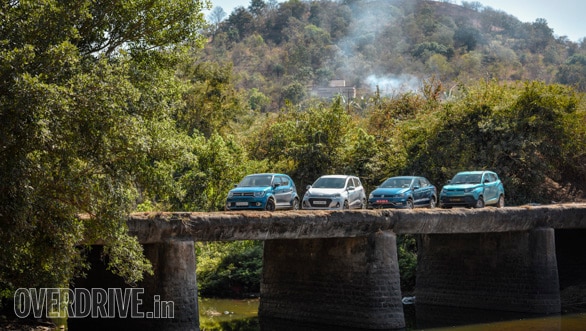
We also brought in a Mahindra KUV100, another offbeat offering in the same price bracket to see if it offers a more unique experience than the Ignis. However, Mahindra was unwilling to give us one, citing that it was an 'SUV' that can't be compared with the others in the test. Still, we believe the KUV fits in, which is why we went ahead and hired one from Zoomcar for this shoot.
Design and style
There's no question here that the Ignis and KUV100 will attract the most attention on the road with their offbeat design there's just nothing else like them on the road. To me the Ignis has got the perfect mix of fun, quirky and sporty without being overdone. I'm sure a lot of you will disagree, but design is a matter of personal preference, and personally I love it. Everything about it the DRLs, flared wheel arches, black alloys, the three slats above the rear wheel arch and the angled bootlid add a lot of character. Additionally, Maruti's offering a ton of personalisation accessories, and there are some pretty cool options.
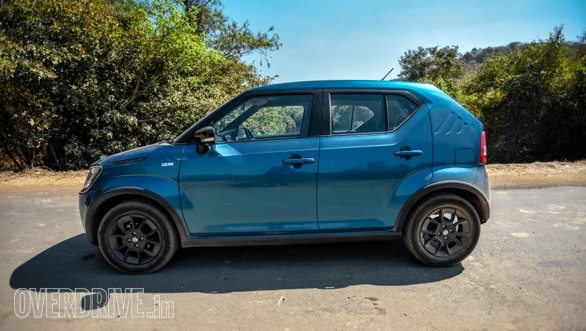 The DRLs, flared wheel arches, black alloys, the three slats above the rear wheel arch and the angled bootlid add a lot of character
The DRLs, flared wheel arches, black alloys, the three slats above the rear wheel arch and the angled bootlid add a lot of character
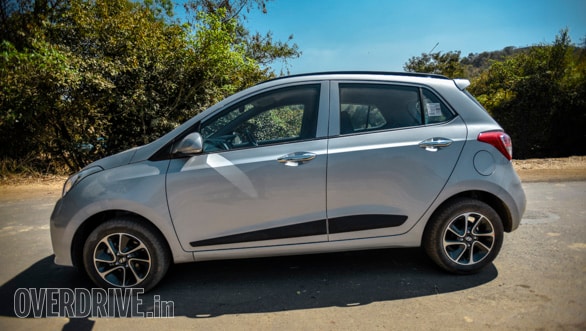 While the facelift does give a slightly sportier look, we really wish Hyundai had done something a little more significant
While the facelift does give a slightly sportier look, we really wish Hyundai had done something a little more significant
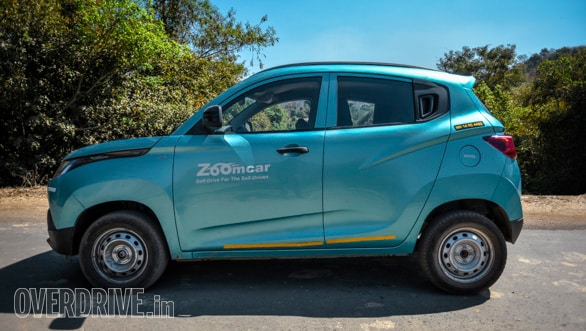 KUV100's design seems a little over the top
KUV100's design seems a little over the top
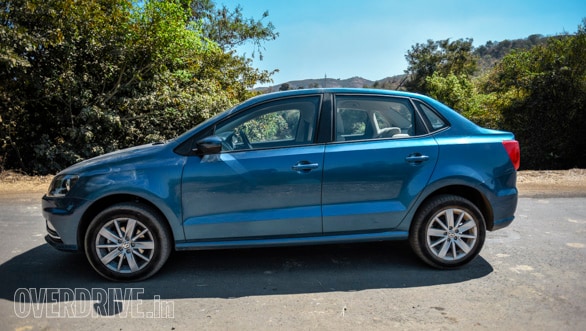 The Ameo adopted everything except the boot from the Polo, it still looks good from most angles
The Ameo adopted everything except the boot from the Polo, it still looks good from most angles
In contrast, the KUV100's design is a little over the top for me. While it doesn't look bad, all the character lines and design elements look a little too overdone and out of proportion. While the pulled-back headlamps with the LED DRLs are quite smart, the bulgy bonnet and the large empty space under the tiny grille seem out of place. From the side, the high roof and compact dimensions make the car look like it's been compressed. The rear, however, is quite proportionately designed and those rectangle lights look nice.
The Grand i10 just received a facelift, and that might be a little hard to believe unless you pay attention. The front end gets a large new sporty hexagonal grille, a new bumper with sportier fog lamp housings and DRLs. The side gets no changes except for a new set of 15-inch alloys, while the rear gets a new bumper with a large black plastic strip which houses the number plate and reflectors. It's certainly a good design with a European touch, but it's been around for four years, which in car years feels close to 10. While the facelift does give a slightly sportier look, I really wish Hyundai had done something a little more significant.
Volkswagen, however, has somehow managed to keep the Polo's design as modern and as up to date as the other cars in the market with very minimal changes over the years. Since the Ameo adopted everything except the boot from the Polo, it still looks good from most angles. The added boot looks fine from the back, but from the side, it looks like a knife sliced off half the boot. But that's an issue we face with almost all the sub-4m sedans in the market today.
Interior and space
Like the exterior, everything about the Ignis' interior is funky and fresh. It's a very youthful design with really nice touches like the tablet-like touchscreen system and the toggle-switches for the aircon controls. The black and white colour scheme ensures the cabin doesn't look too tiny, but the white does tend to get dirty very soon. There's a good amount of space inside too for four passengers. Although there is a seat belt at the back for the fifth person, there isn't enough space to fit three adults there. Plastic quality is typically Maruti Suzuki it's not bad, but not amazing either.
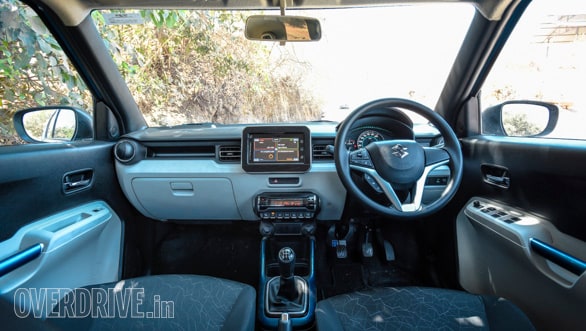 It's a very youthful design with really nice touches like the tablet-like touchscreen system and the toggle-switches for the aircon controls
It's a very youthful design with really nice touches like the tablet-like touchscreen system and the toggle-switches for the aircon controls
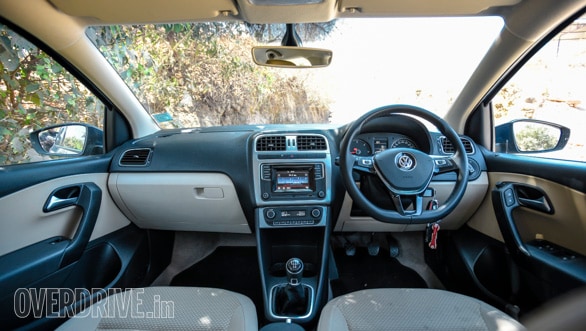 The quality materials, a neat but simple design lend the cabin a very upmarket feel in the Ameo
The quality materials, a neat but simple design lend the cabin a very upmarket feel in the Ameo
 Hyundai hasn't done anything to spruce up the interior either , except for adding a touchscreen and automatic climate control
Hyundai hasn't done anything to spruce up the interior either , except for adding a touchscreen and automatic climate control
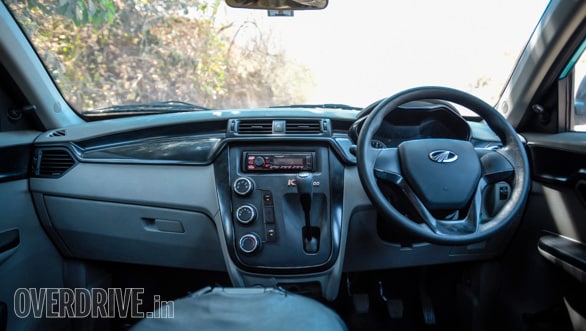 The KUV, even in the top-spec K8 trim lacks the features found in the other cars here
The KUV, even in the top-spec K8 trim lacks the features found in the other cars here
Unfortunately for the Grand i10, Hyundai hasn't done anything to spruce up the interior either. It's identical to the previous car, save for the addition of a new touchscreen system and climate control. Again, it's not a bad place to be in. In fact, the excellent build quality and ergonomic design along with the beige and black theme make it look and feel far more upmarket than the Ignis. However, we're quite used to seeing the same design theme on all the Hyundai cars and it's starting to get a bit too familiar. While shoulder room isn't as much as in the Ignis, it does have the most head and kneeroom of all the cars in this test.
The Ameo's dashboard is identical to that of the Polo. That means quality materials, a neat but simple design and a very upmarket feel. That said, I'm not a big fan of the silver finishing around the centre console it looks a bit plastic-y and a bit out of place. The light colours all around the cabin make it feel a little roomier, but once you sit in the back seat you realise how little space there actually is. The Polo is infamous for having poor kneeroom and the Ameo, being based on the same platform, faces the same problem. But while it has the lowest kneeroom here, it does have the most shoulder room and the largest boot, with a capacity of 330 litres.
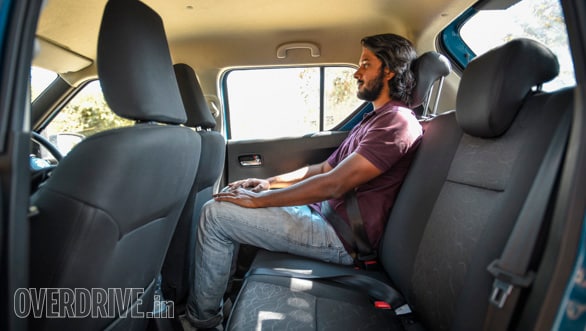
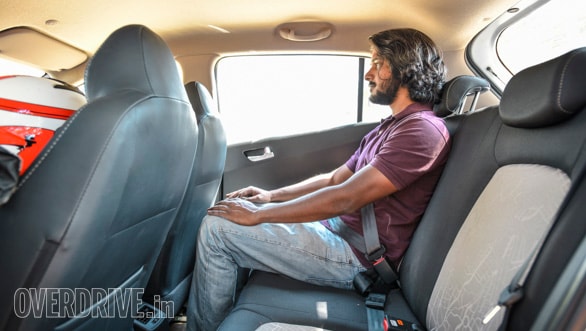
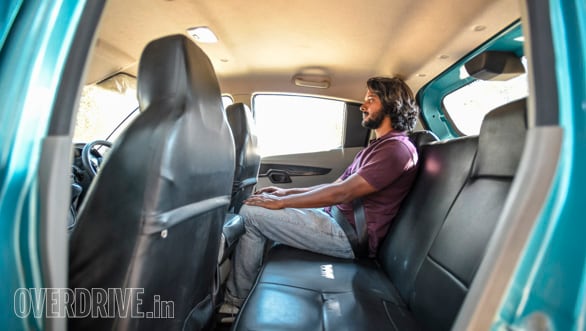

Compared to all the other cars here, the Mahindra KUV100's interior looks very basic. While plastic quality isn't bad, it isn't the best either. The dashboard layout is simple and neat, but not as ergonomic as I would have liked. The car we drove here wasn't the top-spec variant with Mahindra's infotainment system, but during an earlier test, I remember not being too happy with the way the controls were positioned. However, overall cabin space is quite impressive, and sits just below the Grand i10 in terms of kneeroom and below the Ameo for shoulder room. Where it does fall behind is boot space. With a capacity of 243 litres, it has the smallest boot here, and the shape of the tail lamps are very intrusive while loading luggage.
Engine and performance
The Ignis uses the same old, proven 1,248cc Multijet diesel engine that produces 75PS at 4,000rpm and 190Nm at 2,000rpm. Right from the way it starts up, to the turbo lag till around 1,700rpm followed by a quick climb up the rpm meter to the redline, everything about it is just very familiar. The peaky engine takes some getting used to, but once you understand the powerband, it's really good fun to drive. And the precise 'click-click' of the gearbox when you shift only makes the experience so much better. NVH levels are quite good, but this engine is known to get louder with time and use.
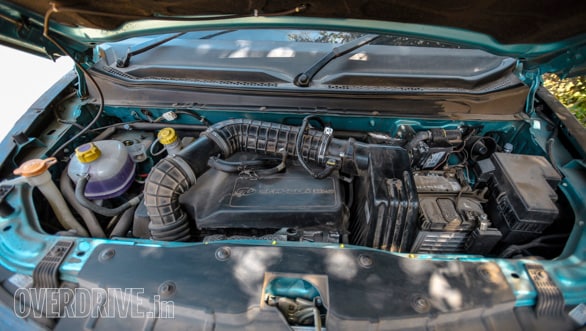 The KUV100 feels like a typical Mahindra to drive with its strong low-end grunt
The KUV100 feels like a typical Mahindra to drive with its strong low-end grunt
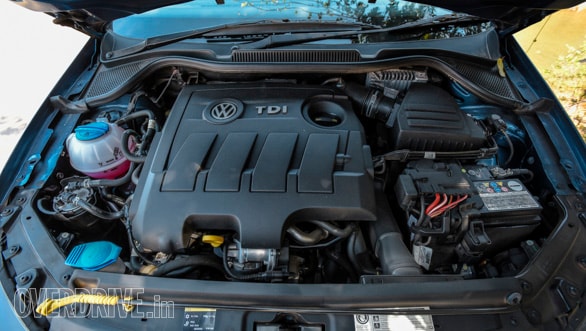 While there is also a good amount of low-end grunt, power delivery in the Ameo isn't linear
While there is also a good amount of low-end grunt, power delivery in the Ameo isn't linear
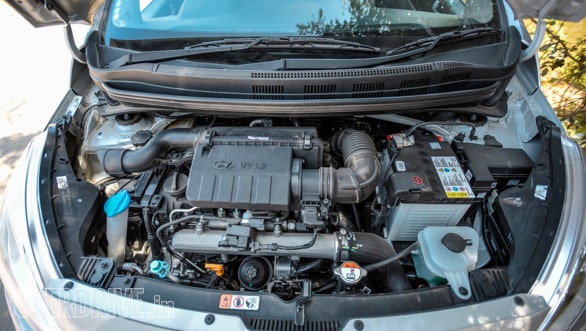 Power delivery in the Grand i10 is far more linear than in the Ignis too, and you'll find yourself shifting gears a lot less in slow-moving traffic
Power delivery in the Grand i10 is far more linear than in the Ignis too, and you'll find yourself shifting gears a lot less in slow-moving traffic
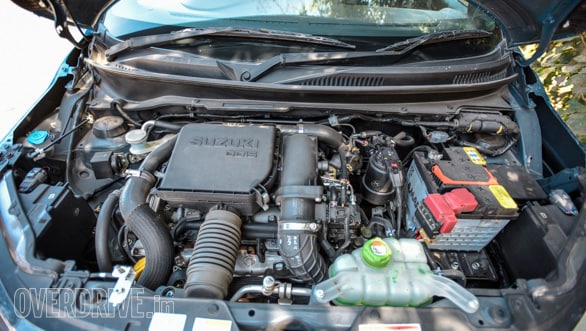 The Maruti engine is a familiar unit and has some amount of turbo lag lower down the rev range
The Maruti engine is a familiar unit and has some amount of turbo lag lower down the rev range
While Hyundai hasn't done a lot to change the car aesthetically, they have worked a fair bit on its diesel engine. The 3-cylinder unit now displaces 1.2 litres from the previous 1.1, and makes 75PS at 4,000rpm and 190Nm from 1,750-2,250rpm. Those are identical figures to the Multijet with a lower and longer torque peak. While it sounds like a typical 3-cylinder engine from the outside, NVH levels are so good that you can barely hear the engine inside, especially on the move. Power delivery in the Grand i10 is far more linear than in the Ignis too, and you'll find yourself shifting gears a lot less in slow-moving traffic. The 5-speed transmission is super-slick and precise, which makes the whole driving experience feel very upmarket. It's more relaxing than exciting, unlike the Ignis, and power fizzles out as you get closer to the redline.
The KUV100 also runs a 3-cylinder turbo-diesel engine making 77PS at 3,750rpm and 190Nm from 1,750-2,250rpm. The engine in the car we drove during this test was quite loud, but I don't blame it because it had clearly been used and abused for almost 20,000km. On our previous road test, we found that there was some engine noise creeping into the cabin, but it wasn't intrusively loud. The KUV100 feels like a typical Mahindra to drive with its strong low-end grunt. There is some lag, but that didn't stop it from chugging along without complaint at around 30kmph in fifth gear. The KUV is also the most frugal car here with an overall efficiency of 19.9kmpl, while the Grand i10 takes second with 18.91kmpl. The gearbox on the Mahindra is quite nice to use too, but the unusual placement of the shifter takes some getting used to.
The most powerful car of this lot by a significant margin is the Ameo, with its Vento-sourced 4-cylinder turbodiesel. It produces 110PS at 4,000rpm and 250Nm right from 1,500-3,000rpm. So it's no surprise that it's the quickest of this lot to get from 0-100kmph, with a time of 10.8s. The Ignis is second with 13.5s. The Ameo has got a really strong mid range and top end which means that there is significant pull even at high triple-digit speeds. While there is also a good amount of low-end grunt, power delivery in the Ameo isn't as linear as in the Grand i10 and it's not as quiet inside the cabin either.
Ride and handling
I really think that the Ignis is one of the most fun cars in the sub-Rs 10 lakh range. Body roll is well controlled and the wide track keeps the car stable around the bends. However, the only thing that does hold you back is the steering. While it is precise and very direct, it simply doesn't weigh up well enough as the speed increases. And that isn't very confidence inspiring, especially at highway speeds. While the car is quite stable till around 140kmph, anything above that can be a little unnerving, especially if there are crosswinds.
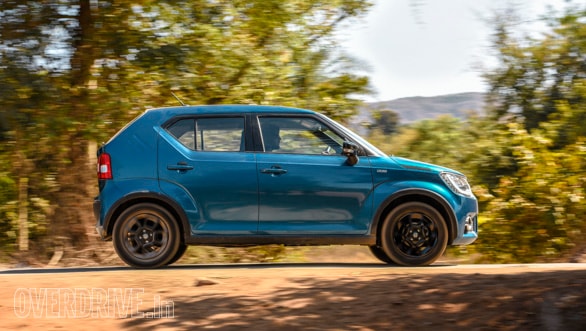 Body roll in the Ignis is well controlled and the wide track keeps the car stable around the bends
Body roll in the Ignis is well controlled and the wide track keeps the car stable around the bends
Over bad roads, the Ignis behaves like a typical Maruti Suzuki with loud thuds if you don't slow down. The smaller ruts are absorbed fairly well at city speeds, but the larger ones won't be very comfortable. The firm damping also means that undulations on the highway aren't absorbed very gracefully.
In contrast, the Grand i10's suspension set-up makes the car feel like it is from a segment above its own. Like the newer Hyundais, the suspension feels supple and absorbs most bumps and holes with a nicer-sounding thump, rather than a thud. It's also quite stable on the highway till around 140kmph, after which the lack of top-end grunt holds you back rather than stability.
However, the softer set-up means it isn't the most fun car to drive down a mountain road because it tends to roll more than the Ignis when you push it. Additionally, the Grand i10's steering, which really is a big, big improvement from the previous car in terms of feel, still isn't among the best.
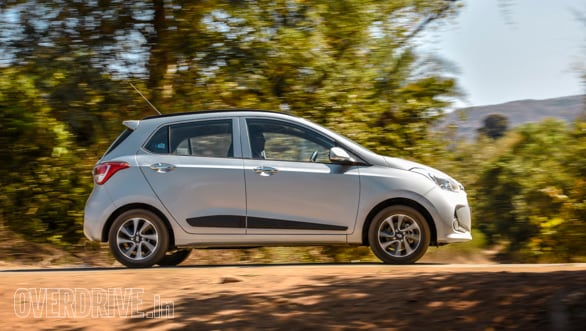 Like the newer Hyundais, the suspension feels supple and absorbs most bumps and holes with a nicer-sounding thump, rather than a thud
Like the newer Hyundais, the suspension feels supple and absorbs most bumps and holes with a nicer-sounding thump, rather than a thud
The KUV100 suffers a similar problem with its steering except, when the Grand i10's steering weighs up at higher speeds, this one's doesn't. There is a fair amount of body roll thanks to the tall stance, but grip levels are still impressive. But its strong suit is its rugged, unbreakable feel that you'd expect from a Mahindra. You can drive over the roughest patch of roads without having to slow down, feeling confident that nothing will break despite the loud thuds from the suspension. The set-up is quite soft, so it absorbs the bumps really well. But it also means that without a fully loaded cabin and boot, the car gets bouncy and unsettled over undulations on the highway.
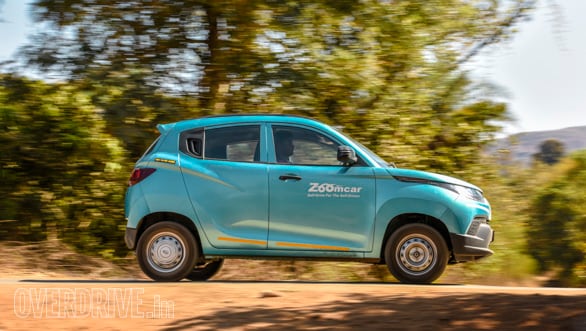 There is a fair amount of body roll in the KUV thanks to the tall stance, but grip levels are still impressive
There is a fair amount of body roll in the KUV thanks to the tall stance, but grip levels are still impressive
On the contrary, the Ameo is a delight on smooth tarmac and is easily the most involving car here to drive. The damping is a little more on the supple side, so the smaller ruts are handled quite comfortably. But anything larger and it will protest with loud thuds.
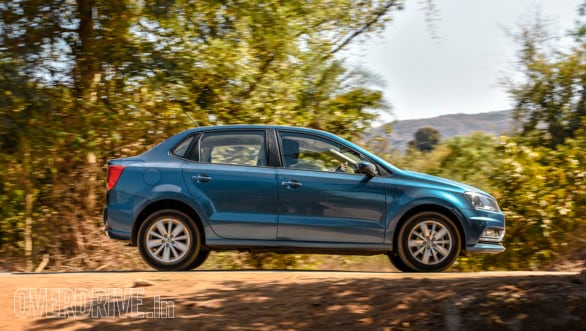 The Ameo is a delight on smooth tarmac and is easily the most involving car here to drive
The Ameo is a delight on smooth tarmac and is easily the most involving car here to drive
Take it on a nice winding road and you'll fall in love. Its steering is the best here because it weighs up perfectly at higher speeds, feels precise and offers very good feedback. Body roll is limited and quick direction changes are made with ease and composure. At the same time, high-speed stability is very impressive.
Safety and features
Full points to Maruti and Volkswagen for offering ABS and dual airbags as standard features on the Ignis and Ameo. Mahindra also scores well here with ABS as a standard feature, while dual airbags are offered as an option right from the base variant. Hyundai, on the other hand, has disappointed in terms of safety features. While a driver's side airbag is standard, dual airbags are available only on the top three trims. ABS, on the other hand, is available only on the top-spec Asta trim and not even offered as an option on the lower variants.
Apart from the LED headlights available on the Ignis, all the cars here, except the KUV100, are almost evenly matched in terms of features. They get automatic climate control, a touchscreen infotainment system, keyless entry, reverse parking sensors with a camera and steering-mounted controls. However, while the Ameo is the only one with features like four anti-pinch auto-up/down windows and rain-sensing wipers, it loses out on keyless ignition, Android Auto and Apple CarPlay, which the Ignis and Grand i10 offer. The Ameo gets a couple of extra points like the Grand i10 for offering rear AC vents.
The KUV100's interior, even in top trim, is comparatively basic with a two-DIN infotainment system that features Bluetooth connectivity, steering-mounted controls and a manual air-conditioning system.
Verdict
The Ignis is a really nice car - it's unique, fun to drive, offers good safety and has a ton of character. But all of that just doesn't justify the Rs 9.56 lakh (on-road, Mumbai) price tag. This, especially when the Rs 8.75 lakh Hyundai Grand i10 feels far more premium and offers just as many features, is nearly a lakh cheaper. So if it's a hatchback you want, the Grand i10 is the more practical and sensible option of the two. That said, you could always opt for a lower-spec Ignis, in which case you'll lose out on features like the LED headlights, auto climate control and touchscreen system, but still be comfortable knowing you're getting airbags and ABS. Unfortunately, Hyundai's scanty safety feature offering means only the top Grand i10 is worth considering in our books.
At Rs 9.03 lakh, the KUV100 is still stuck somewhere in the middle, and while it is a rather unique product, it doesn't offer too many features to make it a convincing buy. That said, if you're in a more rural area or your commute involves bad roads, this is the ideal car.
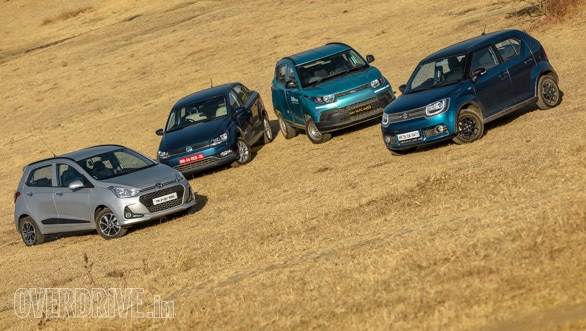
If luggage space is a priority, a compact sedan like the Volkswagen Ameo is definitely worth considering. The Ameo offers a bigger engine, a bigger boot and a better driving experience for Rs 63,000 more than the Ignis. But if that's a bit of a stretch on your budget or if the Ameo isn't your cuppa tea, there are plenty of other cars in this segment like the Rs 10.03 lakh Ford Figo Aspire which, in our books, is one of the best compact sedans in the market. The Hyundai Xcent will also get the new 1.2-litre engine soon, making it worth serious consideration as boot space is one of the Grand's few shortcomings.
Ultimately, it depends on what you're looking for and the Ignis certainly beckons with its funky design and fun to drive factor. However, the high price demands serious consideration before making the buying decision.
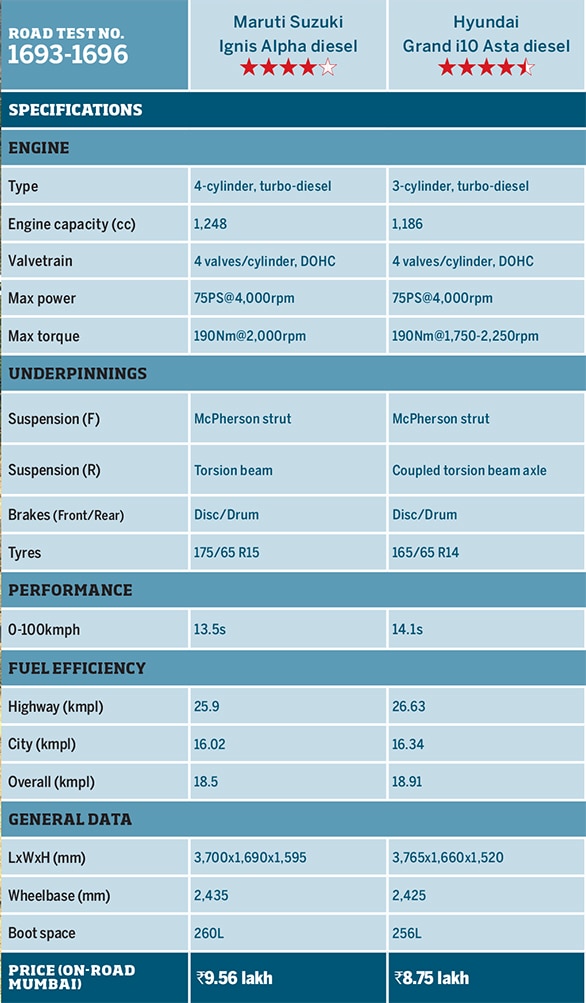
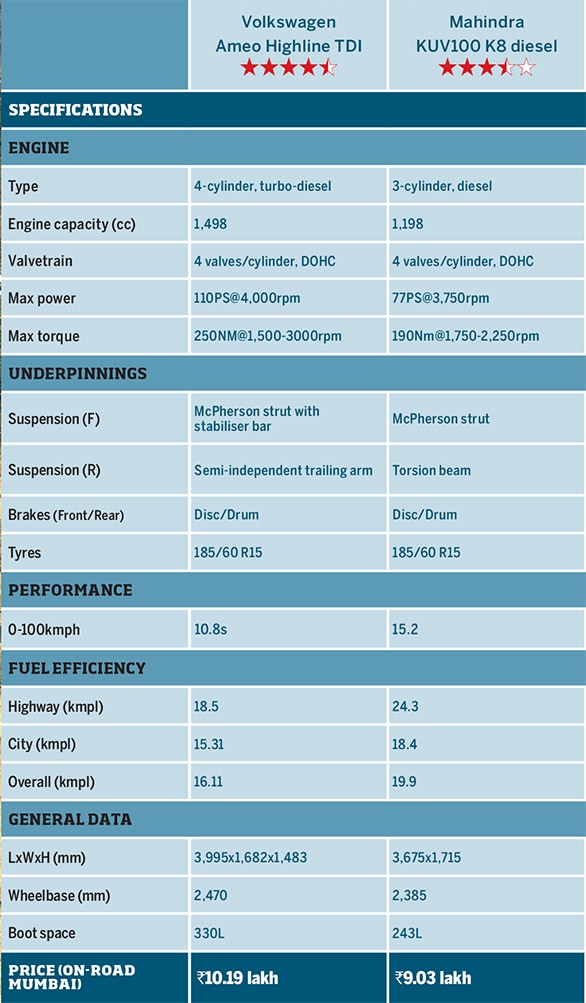
Images by Anis Shaikh
Starts Rs 4.98 Lakhs
1186cc
Manual
75
194
24.95 Kmpl
Starts Rs 5.96 Lakhs
1498cc
Manual
76
250
21.66 Kmpl
Starts Rs 4.89 Lakhs
1197cc
Automatic
82.93
113
20.89 Kmpl
Starts Rs 7.75 Lakhs
1194cc
Automatic
96
119
16 Kmpl
-NA-
1591cc
Manual
-NA-
154
17.01 Kmpl
Starts Rs 5.73 Lakhs
1120cc
Manual
72
190
25.4 Kmpl
-NA-
1198cc
Manual
-NA-
190
25.32 Kmpl














